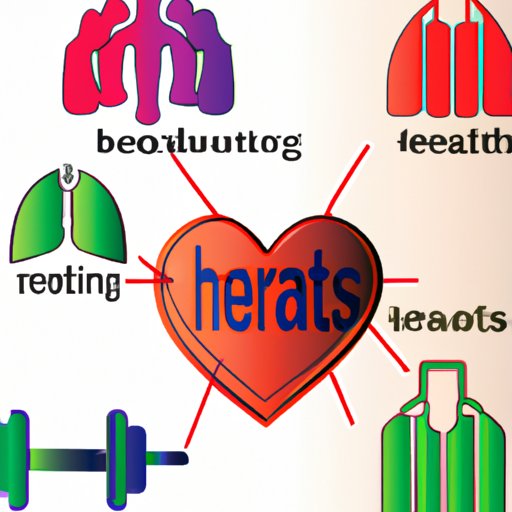Introduction
Cardiorespiratory fitness is an important component of overall physical health and well-being. It is defined as the body’s ability to deliver oxygen to the working muscles and efficiently remove waste products from the body during exercise. Cardiorespiratory fitness has been linked to numerous health benefits, including improved metabolism, lower risk of chronic disease, and stronger heart function. In this article, we’ll explore what cardiorespiratory fitness is and how it works, as well as provide tips for improving your own cardiorespiratory fitness.
Explaining Cardiorespiratory Fitness and How It Works
To understand cardiorespiratory fitness, it’s important to have a basic understanding of the anatomy involved in this type of exercise. The lungs, heart, and circulatory system all work together to move oxygen to the muscles and remove waste products from the body. During exercise, the lungs take in oxygen and the heart pumps it through the arteries to the working muscles. The circulatory system then carries away the carbon dioxide and other waste products, which are then expelled through the lungs.
There are several types of exercise that can improve cardiorespiratory fitness, such as aerobic exercise, strength training, and flexibility exercises. Aerobic exercise involves activities that increase the heart rate and breathing rate, such as running, cycling, swimming, and walking. Strength training helps build muscle mass, which increases the body’s ability to use oxygen more efficiently. Flexibility exercises, such as stretching and yoga, help improve circulation and reduce the risk of injury.

The Role of Cardiorespiratory Fitness in a Healthy Lifestyle
Regular cardiorespiratory exercise has numerous benefits for physical and mental health. According to the American Heart Association, regular cardiorespiratory exercise can help improve cardiovascular health, reduce stress, strengthen bones and muscles, and lower the risk of heart disease, stroke, and other chronic illnesses. In addition, regular cardiorespiratory exercise has been shown to improve mood and energy levels, as well as reduce the risk of obesity.
To get the most benefit from cardiorespiratory exercise, the American College of Sports Medicine recommends adults participate in at least 150 minutes of moderate-intensity aerobic activity per week, or 75 minutes of vigorous-intensity aerobic activity per week. In addition, they recommend strength training at least two days per week and flexibility exercises on at least two days per week.
Understanding the Different Types of Cardiorespiratory Exercise
Aerobic exercise is any activity that increases the heart rate and breathing rate, such as running, cycling, swimming, and walking. These activities are beneficial for improving cardiorespiratory fitness because they require the body to use oxygen more efficiently. Strength training helps build muscle mass, which increases the body’s ability to use oxygen more efficiently. Examples of strength training exercises include weight lifting, bodyweight exercises, and resistance bands.
Flexibility exercises, such as stretching and yoga, help improve circulation and reduce the risk of injury. These exercises also help improve range of motion and flexibility, which can help improve overall performance in physical activities. Finally, balance exercises, such as tai chi and Pilates, help improve coordination, stability, and posture.

Tips for Improving Your Cardiorespiratory Fitness
Developing an effective exercise plan is essential for improving cardiorespiratory fitness. Start by talking to your doctor about the best type of exercise for you, as well as any limitations you may have. Then, create a plan that includes different types of cardiorespiratory exercise, such as aerobic exercise, strength training, and flexibility exercises. Aim to complete each type of exercise at least two times per week.
In addition to exercise, eating a healthy diet is important for improving cardiorespiratory fitness. Eating a balanced diet that includes plenty of fruits, vegetables, whole grains, and lean proteins will help fuel your body for exercise and provide essential vitamins and minerals. Also, be sure to stay hydrated by drinking plenty of water throughout the day.
Finally, incorporating variety into your workout is key for improving cardiorespiratory fitness. Try different types of exercises each week and mix up the intensity and duration of your workouts. This will help keep you motivated and engaged in your exercise routine.

Examining the Relationship Between Cardiorespiratory Fitness and Other Health Factors
Cardiorespiratory fitness is closely linked to other health factors, such as improved metabolism, lower risk of chronic disease, and strengthened heart function. Regular aerobic exercise has been shown to increase the body’s metabolic rate, which means it burns more calories even when at rest. This can help with weight loss and weight management.
In addition, regular cardiorespiratory exercise has been linked to a lower risk of chronic diseases, such as heart disease, stroke, diabetes, and certain cancers. Finally, strengthening the heart through regular cardiorespiratory exercise can help reduce the risk of heart attack and stroke.
Conclusion
Cardiorespiratory fitness is an important component of overall physical health and well-being. It is defined as the body’s ability to deliver oxygen to the working muscles and efficiently remove waste products from the body during exercise. Regular cardiorespiratory exercise has numerous benefits for physical and mental health, including improved metabolism, lower risk of chronic disease, and strengthened heart function. To improve your own cardiorespiratory fitness, aim to complete at least 150 minutes of moderate-intensity aerobic activity per week, or 75 minutes of vigorous-intensity aerobic activity per week, as well as incorporate strength training and flexibility exercises into your routine.
(Note: Is this article not meeting your expectations? Do you have knowledge or insights to share? Unlock new opportunities and expand your reach by joining our authors team. Click Registration to join us and share your expertise with our readers.)
